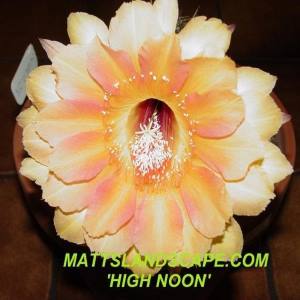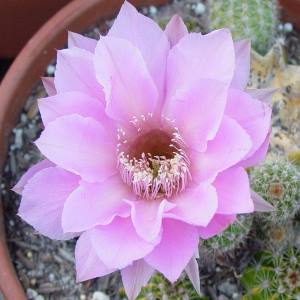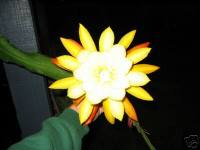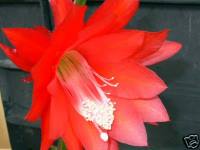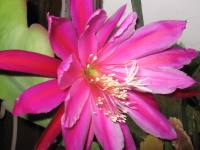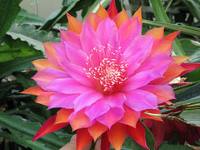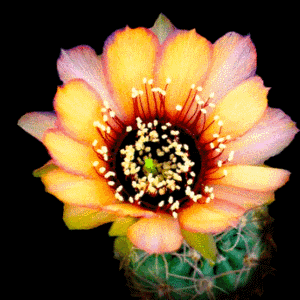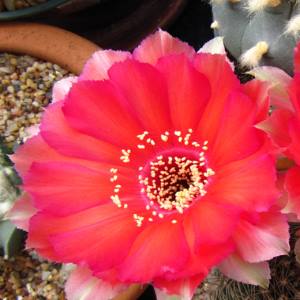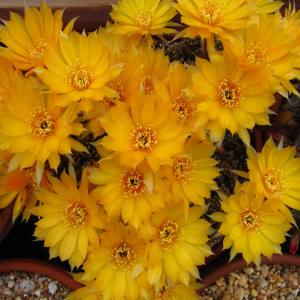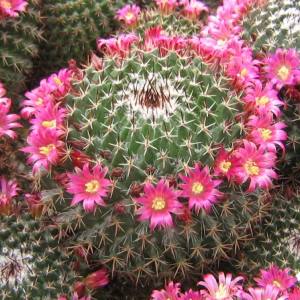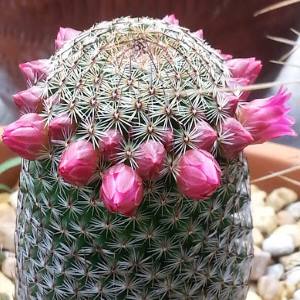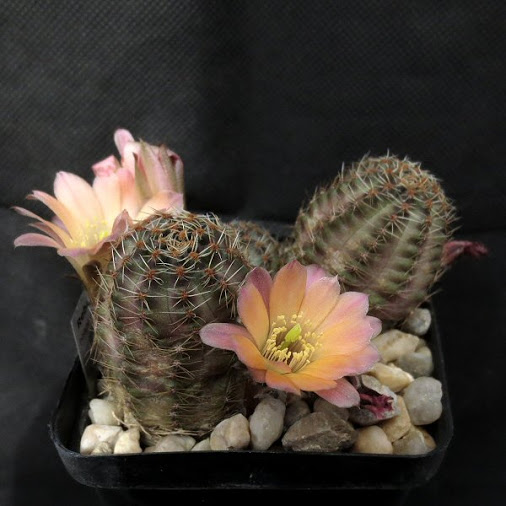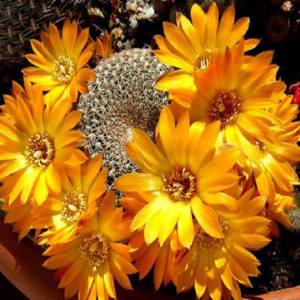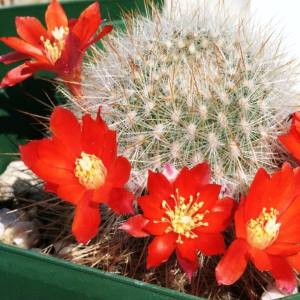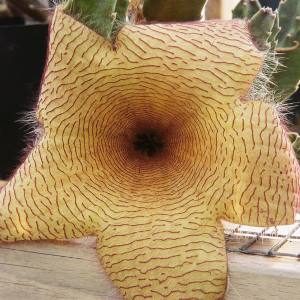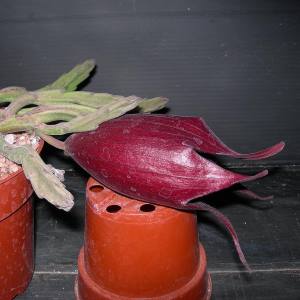Echinopsis is a large genus of cacti native to South America, sometimes known as hedgehog cactus, sea-urchin cactus or Easter lily cactus, mostly because some varieties produce long white creamy funnel shaped flowers around Easter. A beginner’s species E. chamaecereus, is known as the peanut cactus. This now over reached genus now includes large and treelike types to the more common globose forms that now includes the Lobivia and the hybrid Lobivopsis.
In nature they range through Argentina, Bolivia, Brazil and Paraguay. The spiny appearance of these plants earned part of their name meaning hedgehog or sea urchin. Plant shapes and sizes vary over a range from small globular cacti to large columnar branching varieties. Some species grow in long stem sprawling formations, and can even be hanging basket plants. As a species they are a vague collection of cacti, and a large group with over 125 species. Throw in hybridization and there are many more.
Their reputation for producing impressive flowers is well deserved although the flowers usually come out at night and only last for one or two days in mid to late summer. With the wide range of color variations it seems possible that a person could collect Echinopsis or Lobivia for a lifetime.
Echinopsis Multiplex oxygona, Echinopsis HIGH NOON -Trichocereus, Echinopsis TUFFET – Lobivia
Epiphylium: are much branched epiphytes, meaning they need well drained soil but plenty of drizzle. Their native habitat being Costa Rica, S. Mexico, Guatemala and down to Brazil provide them with that. As a houseplant they would require good misting. Cold hardiness depending upon their collected origin may be a bit tougher than is often mentioned.
I also found that they prefer semi-shade so plopping them in a S. facing window or the same in a greenhouse may be the kiss of death. Oak leaf mold added to a basic cactus (or bonsai mix) should provide a good soil base. Remember – Well Drained! The shear number of hybrids of this gaudy hanging plant is beyond imagining.
Lobivia is an anagram of Bolivia from where many of this genus species originate. Lobivia is now swallowed up in the genus Echinopsis. Like the parent genus, the Lobivia family are South Americans cacti (Argentina, Bolivia, Peru) and are appreciated by the collectors for their bright blooms.
The descriptions and re-assigning it to the family of Echinopsis has always troubled me. Their even were hybrid CROSSES between Lobivia and Echinopsis that became identified as Lobivopsis. All of these need a very bright position in order to produce the abundance of flowers that they are known for.
Mammillaria is a very large generic with most of its members growing in Mexico; with some in the southwestern United States, in the Caribbean and a few species scattered from the Central America down to northern South America. The first species was described by Carolus Linnaeus as Cactus mammillaris in 1753, deriving its name from Latin mammilla, referring to the tubercles that are among the distinctive features of the genus. ‘Pincushion Cactus’ is another common name. One that is over used for a great many cacti.
They grow in a wide range of habitat conditions like low elevation grassy planes, sun baked rock cracks, but most of them grow in mountain regions. There may be a lot of variation in shapes sizes and spine colors in this group, but most are small globular cacti.
The flowers are small and come in wide range of flower colors; from creamy to bright yellows, white to pink, magenta to purples, oranges and deep reds too. They are distinctive for the way they form their flowers in a distinct ring around the top of the stems.
Aside from the ‘Peanut Cactus’ this group of plants will be the most shlocked of cactus that you will find in box store nurseries. The reason being that they ARE good ‘windowsill cactus’ and generally are very tough. Winter rationing of water is a must and they can easily survive an entire winter without watering. Mind you this includes fertilizing as well. Some plants simply need to REST! Over pampering will mostly lead to their demise.
Mammillaria elongata, Mammillaria mystax, Mammillaria
Parodia is a genus of flowering plants in the cactus family Cactaceae, native to the uplands of Argentina, Peru, Bolivia, Brazil, Colombia and Uruguay. This genus has about 50 species, many of which have been transferred from Eriocactus, Notocactus and Wigginsia. They range from small globose plants to 1 m (3 ft) tall columnar cacti. All are deeply ribbed and spiny, with single flowers at or near the crown. Some species produce offsets at the base. They are popular in cultivation, but must be grown indoors where temperatures stay above 50 degrees.
This genus of mostly globular cacti that are very common in propagation, and are native to the uplands of Argentina, Bolivia, Brazil, Paraguay and Uruguay. Most are globular cacti but some can range to be 3 ft. columnar forms. Given warm winter protection they generally are good survivors. As with all the above they may elongate in the the house due to lack of lumens or being too often watered or fertilized. Good light intensity is a must if you expect them to flower. Keeping them dry over the winter is also very important.
In the hot summer months, you might give them some shade as their skin can burn in a South facing window or even in an unshaded greenhouse. Unlike humans this cosmetic damage cannot be un-done by the plant doctor. (Oh yah, keep all your plants away from your Wi-Fi router.) Parodia require bright light and normal cactus compost.
As the pictures show the flowers range from the yellows through deep reds.
 Rebutia: Plant size and shape varies from small globular to fairly large columnar cacti, and Parodia may be thought of more as a kind of lose collection of cacti grouped into one handy botanically genericfamily. Being very individualistic plants with varied growing considerations; like humanoids, it is better to know the origin and growing habits of individual species to understand the cultural care that individual species will need. The challenge for any grower who gathers many varieties of Parodia is learning the uniqueness of growing conditions for this varied group of plants
Rebutia: Plant size and shape varies from small globular to fairly large columnar cacti, and Parodia may be thought of more as a kind of lose collection of cacti grouped into one handy botanically genericfamily. Being very individualistic plants with varied growing considerations; like humanoids, it is better to know the origin and growing habits of individual species to understand the cultural care that individual species will need. The challenge for any grower who gathers many varieties of Parodia is learning the uniqueness of growing conditions for this varied group of plants
Unlike many of the above these need some shading in the summer and seem to be hardier than the Lobivia and Parodia. The planting soil should also be leaning to the acidic which is a bit different from most.
More or less globular plants these, like Lobivia are native to native to Bolivia and Argentina and are generally small, colorful cacti, globular in form, making great windowsill plants. They are fairly easy to grow and they may produce large flowers in comparison to the body of the plant.
The hardiness of this plant is attributed to their more alpine range in Argentina and Bolivia. These small small plants tolerate house plant conditions better than most cacti, and produce brilliantly colored flowers. They are friendly with their offspring as they propagate easily from ‘pups’ and often produce many seedlings if you put a nice grit around the plant. An afterthought, most cacti will benefit with a mulch of grit as this will protect them from soil-borne pathogens
Rebutia pygmaea pallida, Rebutia arenacea, Rebutia pulchella
Stapelia: is a handful of African species that are commonly cultivated as ‘cacti’ pot plants and are even used as rockery plants in countries where the climate is warm. Stapelia are good container plants and can grow well under full sun and light and need only o moderate watering. Planted in well-drained compost and apply a grit cover to the soil as the stems are prone to rotting if over watered and kept too moist.
Known globally as African starfish flowers or locally as carrion flowers, the genus Stapelia are usually characterized by their foul-smelling flowers reminiscent of the odor of rotting meat. The hairs, coloration and surface mimic decaying animal matter and attract mostly flies, which act as pollinators. Some species however, such as S. erectiflora and S. flavopurpurea have sweetly scented flowers, but they are rare. I should add that many people cannot smell them at all.
Stapelias are ground hugging, perennial succulents. The stems, their surface and branching make them immediately recognizable. The stems are almost always erect and are usually uniformly green to lavender or even red, depending on the extent of exposure to the sun. Only rarely are they mottled with red or purple on green.
The plants require a period without water in summer or winter (a dormant phase), depending on whether they come from the summer or winter rainfall area and may show a shriveling affect. This is normal.. Provided that they are not over-watered and are given a warm position, Stapelias will flower and thrive. Mind you they ARE NOT ‘Cacti.’ Many succulents look like cacti, but are not. Mind you cacti are succulents.
As with all cactus or succulents, avoid over-fertilizing and I have found organics to be the preferred choice, or at least alternate with a DILUTED commercial fertilizer such as Miracle Gro!
Stapelia gigantea, Giant Stapellia, Stapelia leendertziae
Check out my hardy cactus page. Opuntia fragilis and others
(C) Herbert Senft 2015


